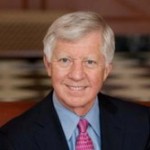Oct13
Bill Clinton & Bill George on Leadership (World Business Forum #wbf09)
Point: Leaders must communicate and connect, which means providing vision and revealing vulnerability
Story: At the World Business Forum last week, former President Bill Clinton was asked about his lessons on leadership. His answer was threefold: 
- It begins with a vision of where you want to go: you have to articulate where you are, where you want to go, and how to get there
- A leader has to continually communicate and sell the vision
- Leaders need to understand people, not just policies
That last point about leaders needing to understand people was the comment that was most retweeted during the live-tweeting of Clinton’s talk. It was the point that resonated the most deeply with the audience.
Fittingly, Clinton’s closing comments provided the perfect circle back to Bill George’s opening keynote the day before. Bill George, former Medtronic CEO under whose leadership the company’s market cap grew from $1.1 billion to $60 billion, spoke about authentic leadership during a time of crisis.
Being authentic builds trust and helps people understand who you are as a leader. “In a time of crisis, you  need people who tell you the truth,” George said. Authenticity requires strength because it means, at times, revealing vulnerabilities. Although revealing vulnerabilities seems counterintuitive and very hard for leaders who want to seem all-knowing, George has said:
need people who tell you the truth,” George said. Authenticity requires strength because it means, at times, revealing vulnerabilities. Although revealing vulnerabilities seems counterintuitive and very hard for leaders who want to seem all-knowing, George has said:
“When you open yourself up to others and share your fears and shortcomings, you connect with people at a deeper level. Exposing your vulnerabilities is an open invitation for others to share openly with you. In the process, you gain a higher level of support and commitment from people, as well as their respect.”
How much do you share? Bill George offered an example from his own life: As Medtronics’ CEO, he regularly sent out emails to all the employees about the state and health of the company. In 1996, seven years into his tenure as CEO, George’s wife was diagnosed with cancer. George found himself writing an email to employees revealing his wife’s personal health rather than presenting the company’s financial health. To George’s surprise, 18,000 employees (more than half the company) replied to his email, offering their support and sharing their own stories of loved ones who had battled cancer. “It was a personal connection,” George reflected. “We’re hungry for those connections.”
Action
- Build personal connections with those you lead
- Create, communicate, and cultivate a vision
- Be authentic, revealing both weaknesses and strengths
For More Information
Bill George is the author of the new Seven Lessons for Leading in Crisis and bestsellers Authentic Leadership
and True North
Bill George’s blog is at http://www.billgeorge.org/blog/
[Bill George shared the email story during a pre-forum reception he held for World Business Forum Bloggers on Oct. 5, 2009]
75jtpgi24x
2 Comments »Case study, CEO, How-to
2 Responses to “Bill Clinton & Bill George on Leadership (World Business Forum #wbf09)”










Rosemary Carstens Oct 21st 2009 at 02:24 pm 1
George and Clinton on SO on target! People long for genuine connection to others, especially those they are looking to for guidance and leadership. We more willingly follow those who forgo “preaching from the mount” or esoteric advice handed out in jargon and buzz. Studies are proving that today people value input much more highly that they feel comes from their own community of peers. A remarkable leader is not afraid to let others know she or he struggles with issues, too, and yet reveals the value of persistence and courage in accomplishing the goal.
Claire Walter Nov 1st 2009 at 05:36 pm 2
Clinton’s 3 points are interesting. He (and other successful politicians) understand people sufficiently enough to get elected, but their foes often knee-cap on policy issues when their agendas are different. (Clinton, of course, had other issues in his second term, but he was “gotten” with his health-care reform policies).